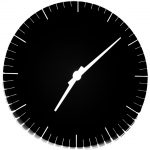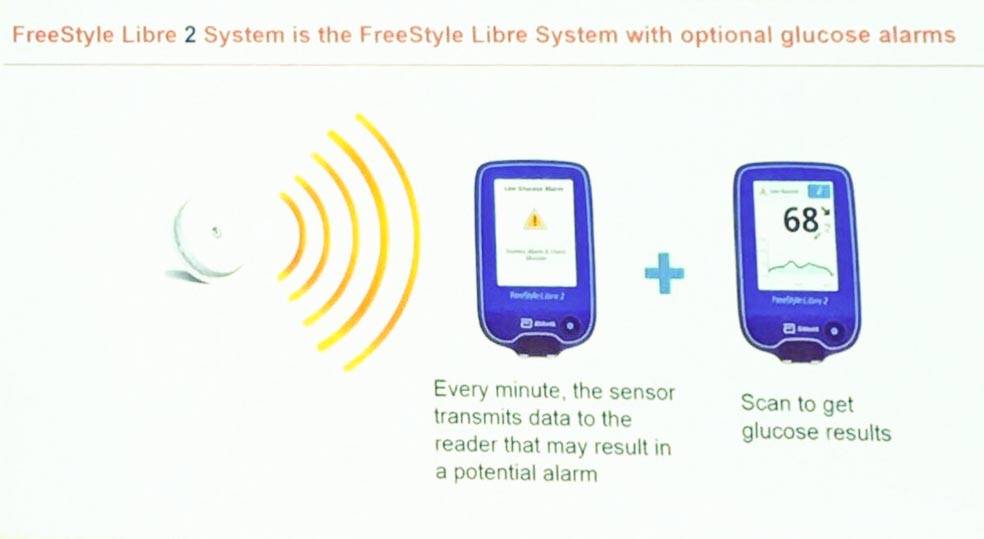The Abbott Libre “flash” glucose monitoring system has been available in Australia since June 2016. It currently costs almost $95 per fortnight, and just like the CGM systems there’s no funding subsidy available yet. But meanwhile, this week at the EASD meeting in Berlin, Abbott have announced their new “Libre 2” system. We have known for ages from Abbott’s involvement with Bigfoot Biomedical that something like this will be coming, but it’s good to finally see some detail.
The new system will use Bluetooth to communicate with the Reader device (and presumably their phone app). In doing so it introduces the alarms which have distinguished CGMs from the Libre. We don’t yet have full details, nor do we have a timeframe for when it might get introduced in Australia (although it has received CE approval for Europe already) but it will apparently be priced the same as the existing Libre system.
Unlike the “Libre 1” where the sensor quietly gathers data but only reports when the user actively scans it with a device, the Libre 2 sensor communicates every minute to the Reader 2 device via Bluetooth LE, which can then trigger alarms. The Reader 2 will still require you to scan the sensor to retrieve the full historical data. Quite apart from those new features (and adding alarms will be a big change to the functionality!) this opens up new options for the future.
However, there’s a lot we do not know about the Libre 2 yet. It is possible that the device transmits the current glucose data every minute (and if the device is used by Bigfoot’s systems that seems likely) and hopefully that’s the case. But it’s also conceivable that it only transmits alarm signals, which will be a lot more limited. Time will tell.
#WeAreNotWaiting
To match the functionality of the current Libre system, where a sensor can get paired with a Reader and the LibreLink phone app, presumably the Libre 2 sensor can get paired with a Reader 2 and a phone via Bluetooth.
It seems reasonable to assume that the Libre 2 will form the CGM component of Bigfoot’s upcoming Automated Insulin Delivery systems.
It also seems reasonable to assume that the #WeAreNotWaiting community won’t wait too long to work out how to link the sensor via Bluetooth to CGM systems such as xDrip+ and Spike. This may cut into the market for third-party devices such as the MiaoMiao and the BluCon Nightrider (which are linked to these CGM systems via Bluetooth and scan the Libre 1 via NFC) but those have always seemed like stop-gap products solving a shortcoming of one particular product (the first-generation Libre).
Per-minute data
The Libre has always worked by gathering glucose data from the interstitial fluid every minute. When you scan the sensor it downloads the per-minute raw data for the last 15 minutes or so, with averaged per-15-minute data for the last 8 hours. The Abbott algorithm uses the per-minute data to indicate a “trend arrow” and to attempt to extrapolate a value that will match the current blood glucose value. When you upload the historical data from the Reader into systems like Diasend or Tidepool you get 15-minute samples.
Most other CGM systems (e.g. those from Dexcom and Medtronic) sample the interstitial fluid every 5 minutes, and the CGM data we all analyse and review retrospectively works quite well with 5-minute and even 15-minute samples. But if we can get per-minute data from the Libre 2 that does open up more options!
 Consider our closed-loop pump systems. Every 5 minutes whenever new glucose data is available, the loop recalculates all its maths and decides whether to change anything about the insulin delivery. But the loops are not locked to 5 minutes: whenever new data appears they can react. Especially when combined with faster-acting insulins in the future, more-frequent CGM data should allow the loop systems to become even more responsive. There are other delays in our systems (such as any blood-to-interstitial glucose lag) but anything we can do reduce any of these delays has to be able to improve the system overall.
Consider our closed-loop pump systems. Every 5 minutes whenever new glucose data is available, the loop recalculates all its maths and decides whether to change anything about the insulin delivery. But the loops are not locked to 5 minutes: whenever new data appears they can react. Especially when combined with faster-acting insulins in the future, more-frequent CGM data should allow the loop systems to become even more responsive. There are other delays in our systems (such as any blood-to-interstitial glucose lag) but anything we can do reduce any of these delays has to be able to improve the system overall.
Some loop systems have been processor-bound, and take a minute or two to finish their calculations and pump communications, so may struggle to keep up with per-minute data. But this is changing. In the past I have configured a Libre-based loop system to sample data every 3 minutes, so I know it’s possible. I did find it increased overall battery consumption of the scanning device I was using at the time so I didn’t stick with it for long, but I know the current loop system I’m using should be able to take advantage of any speed-up.
I’m looking forward to finding out more about the Libre 2 as it becomes available!


Wow, I cannot wait!! Libre is my distinct preference for the ease of insertion at the least.
BluCon will still be very helpful for people who are using FreeStyle 1, 2 etc.. as long any of them as NFC because Libre sensor is so inaccurate and people can’t calibrate in Libre Reader and LibreLink app so xDrip, Spike and LinkBluCon apps are very useful. I am using BluCon for more than 18 months since Ambrosia launched that with xDrip app and later started using LinkBluCon and FollowBluCon app. If Libre 2 will just provide alarm then Abbott’s Caregiver app LibreLinkUp may not be helpful.
I agree with you Anna. By looking at the Libre 2 in Germany it appears Ambrosia’s BluCon is the only way forward as they have all the required software to support the Libre sensor like Patient app LinkBluCon, Caregiver app FollowBluCon and a platform Ambrosia.care to see how readings are changing with the glucose. Simply awesome solution a far better than any other CGM like Dexcom and Medtronic
Agree with the potential of libre2. However, the main issue is the encryption. I cannot understand why Abbot does this since its sales won’t be affected by the out-of-market apps. Furthermore, I honestly think they will increase sales if they enjoy this movement instead of fighting against it. We still will buy sensors, which the main source of sales. Readers is a one-time sale. So, why this limitation? Libre2 already includes a BT transmitter, so why this encryption? My only potential answer is the collection of data. Libreapp is free, Xdrip is free, so really I cannot understand the managers of Abbot and the desire to develop a closed eco-system instead of open-innovation approach. I can foresee that the libre3 will include the transmission of data to the reader without the need of NFC scanning. This incremental innovation strategy is common in the ICT world (Apple, Samsung….) with new products showing only marginal improvements…
Certainly from the consumer point of view, “an interoperable world is a happy world”.
Whether it’s due to an economic “protectionist” model or attempts to make the communications trustworthy and robust (and thus keep the regulators happy about safety), encryption/authentication is unlikely to go away.
Secure communications does not necessarily mean it has to be inaccessible. But I would like to be sure that my CGM is receiving data from my sensor and not someone else’s fake data for example. Encryption/authentication is a necessary tool in this.
My son has developed a contact allergy to freestyle 1. His dermatologist says that freestyle 2 has different glue/plastic and he should be able to use it. Does anyone know how you get hold of the freestyle 2 units? Can you buy them on line?